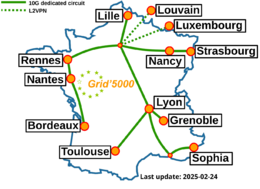Grid5000:Home: Difference between revisions
No edit summary |
No edit summary |
||
| (76 intermediate revisions by 11 users not shown) | |||
| Line 1: | Line 1: | ||
__NOTOC__ __NOEDITSECTION__ | __NOTOC__ __NOEDITSECTION__ | ||
{|width="95%" | |||
|- valign="top" | |||
|bgcolor="#888888" style="border:1px solid #cccccc;padding:2em;padding-top:1em;"| | |||
[[File:Slices-ri-white-color.png|260px|left|link=https://www.slices-ri.eu]] | |||
<b>Grid'5000 is a precursor infrastructure of [https://www.slices-ri.eu SLICES-RI], Scientific Large Scale Infrastructure for Computing/Communication Experimental Studies.</b> | |||
<br/> | |||
Content on this website is partly outdated. Technical information remains relevant. | |||
|} | |||
{|width="95%" | {|width="95%" | ||
|- valign="top" | |- valign="top" | ||
|bgcolor="#f5fff5" style="border:1px solid #cccccc;padding:1em;padding-top:0.5em;"| | |bgcolor="#f5fff5" style="border:1px solid #cccccc;padding:1em;padding-top:0.5em;"| | ||
[[Image: | [[Image:g5k-backbone.png|thumbnail|260px|right|Grid'5000|link=https://www.grid5000.fr]] | ||
'''Grid'5000 is a large-scale and flexible testbed for experiment-driven research in all areas of computer science, with a focus on parallel and distributed computing, including Cloud, HPC, Big Data and AI.''' | |||
Key features: | |||
* provides '''access to a large amount of resources''': 15000 cores, 800 compute-nodes grouped in homogeneous clusters, and featuring various technologies: PMEM, GPU, SSD, NVMe, 10G and 25G Ethernet, Infiniband, Omni-Path | |||
* '''highly reconfigurable and controllable''': researchers can experiment with a fully customized software stack thanks to bare-metal deployment features, and can isolate their experiment at the networking layer | |||
* '''advanced monitoring and measurement features for traces collection of networking and power consumption''', providing a deep understanding of experiments | |||
* '''designed to support Open Science and reproducible research''', with full traceability of infrastructure and software changes on the testbed | |||
* '''a vibrant community''' of 500+ users supported by a solid technical team | |||
<br> | <br> | ||
Read more about our [[Team|teams]], our [[Publications|publications]], and the [[Grid5000:UsagePolicy|usage policy]] of the testbed. Then [[Grid5000:Get_an_account|get an account]], and learn how to use the testbed with our [[Getting_Started|Getting Started tutorial]] and the rest of our [[:Category:Portal:User|Users portal]]. | |||
[[ | |||
| | |||
<br> | |||
Published documents and presentations: | |||
* [[Media:Grid5000.pdf|Presentation of Grid'5000]] (April 2019) | |||
* [https://www.grid5000.fr/mediawiki/images/Grid5000_science-advisory-board_report_2018.pdf Report from the Grid'5000 Science Advisory Board (2018)] | |||
Older documents: | |||
* [https://www.grid5000.fr/slides/2014-09-24-Cluster2014-KeynoteFD-v2.pdf Slides from Frederic Desprez's keynote at IEEE CLUSTER 2014] | |||
* | * [https://www.grid5000.fr/ScientificCommittee/SAB%20report%20final%20short.pdf Report from the Grid'5000 Science Advisory Board (2014)] | ||
<br> | |||
Grid'5000 is supported by a scientific interest group (GIS) hosted by Inria and including CNRS, RENATER and several Universities as well as other organizations. Inria has been supporting Grid'5000 through ADT ALADDIN-G5K (2007-2013), ADT LAPLACE (2014-2016), and IPL [[Hemera|HEMERA]] (2010-2014). | |||
|} | |||
[[ | |||
<br> | <br> | ||
{{#status:0|0|0|http://bugzilla.grid5000.fr/status/upcoming.json}} | |||
<br> | |||
== Random pick of publications == | |||
{{#publications:}} | |||
==Latest news== | |||
<rss max=4 item-max-length="2000">https://www.grid5000.fr/rss/G5KNews.php</rss> | |||
---- | |||
[[News|Read more news]] | |||
=== | === Grid'5000 sites=== | ||
{|width=" | {|width="100%" cellspacing="3" | ||
|- valign="top" | |- valign="top" | ||
|width="33%" bgcolor="#f5f5f5" style="border:1px solid #cccccc;padding:1em;padding-top:0.5em;"| | |width="33%" bgcolor="#f5f5f5" style="border:1px solid #cccccc;padding:1em;padding-top:0.5em;"| | ||
* [[Grenoble:Home|Grenoble]] | * [[Grenoble:Home|Grenoble]] | ||
* [[Lille:Home|Lille]] | * [[Lille:Home|Lille]] | ||
* [[Luxembourg:Home|Luxembourg]] | * [[Luxembourg:Home|Luxembourg]] | ||
* [[Louvain:Home|Louvain]] | |||
|width="33%" bgcolor="#f5f5f5" style="border:1px solid #cccccc;padding:1em;padding-top:0.5em;"| | |width="33%" bgcolor="#f5f5f5" style="border:1px solid #cccccc;padding:1em;padding-top:0.5em;"| | ||
* [[Lyon:Home|Lyon]] | * [[Lyon:Home|Lyon]] | ||
* [[Nancy:Home|Nancy]] | * [[Nancy:Home|Nancy]] | ||
* [[Nantes:Home|Nantes]] | * [[Nantes:Home|Nantes]] | ||
* [[ | * [[Rennes:Home|Rennes]] | ||
|width="33%" bgcolor="#f5f5f5" style="border:1px solid #cccccc;padding:1em;padding-top:0.5em;"| | |width="33%" bgcolor="#f5f5f5" style="border:1px solid #cccccc;padding:1em;padding-top:0.5em;"| | ||
* [[Sophia:Home|Sophia-Antipolis]] | * [[Sophia:Home|Sophia-Antipolis]] | ||
* [[Strasbourg:Home|Strasbourg]] | |||
* [[Toulouse:Home|Toulouse]] | * [[Toulouse:Home|Toulouse]] | ||
|- | |- | ||
|} | |} | ||
== Current funding == | == Current funding == | ||
{|width="100%" cellspacing="3" | {|width="100%" cellspacing="3" | ||
|- | |- | ||
| width="50%" bgcolor="#f5f5f5" valign="top" align="center" style="border:1px solid #cccccc;padding:1em;padding-top:0.5em;"| | | width="50%" bgcolor="#f5f5f5" valign="top" align="center" style="border:1px solid #cccccc;padding:1em;padding-top:0.5em;"| | ||
===INRIA=== | ===INRIA=== | ||
[[Image:Logo_INRIA.gif|300px]] | [[Image:Logo_INRIA.gif|300px|link=https://www.inria.fr]] | ||
| width="50%" bgcolor="#f5f5f5" valign="top" align="center" style="border:1px solid #cccccc;padding:1em;padding-top:0.5em;"| | | width="50%" bgcolor="#f5f5f5" valign="top" align="center" style="border:1px solid #cccccc;padding:1em;padding-top:0.5em;"| | ||
===CNRS=== | ===CNRS=== | ||
[[Image:CNRS-filaire- | [[Image:CNRS-filaire-Quadri.png|125px|link=https://www.cnrs.fr]] | ||
|- | |- | ||
| width="50%" bgcolor="#f5f5f5" valign="top" align="center" style="border:1px solid #cccccc;padding:1em;padding-top:0.5em;"| | | width="50%" bgcolor="#f5f5f5" valign="top" align="center" style="border:1px solid #cccccc;padding:1em;padding-top:0.5em;"| | ||
===Universities=== | ===Universities=== | ||
IMT Atlantique<br/> | |||
Université Grenoble Alpes, Grenoble INP<br/> | |||
Université Rennes 1, Rennes<br/> | |||
Institut National Polytechnique de Toulouse / INSA / FERIA / Université Paul Sabatier, Toulouse<br/> | Institut National Polytechnique de Toulouse / INSA / FERIA / Université Paul Sabatier, Toulouse<br/> | ||
Université Bordeaux 1, Bordeaux<br/> | |||
Université Lille 1, Lille<br/> | |||
École Normale Supérieure, Lyon<br/> | |||
| width="50%" bgcolor="#f5f5f5" valign="top" align="center" style="border:1px solid #cccccc;padding:1em;padding-top:0.5em;"| | | width="50%" bgcolor="#f5f5f5" valign="top" align="center" style="border:1px solid #cccccc;padding:1em;padding-top:0.5em;"| | ||
===Regional councils=== | ===Regional councils=== | ||
Aquitaine<br/> | Aquitaine<br/> | ||
Auvergne-Rhône-Alpes<br/> | |||
Bretagne<br/> | Bretagne<br/> | ||
Champagne-Ardenne<br/> | Champagne-Ardenne<br/> | ||
Provence Alpes Côte d'Azur<br/> | Provence Alpes Côte d'Azur<br/> | ||
Hauts de France<br/> | |||
Lorraine<br/> | Lorraine<br/> | ||
|} | |} | ||
Latest revision as of 10:02, 11 July 2025
|
Grid'5000 is a precursor infrastructure of SLICES-RI, Scientific Large Scale Infrastructure for Computing/Communication Experimental Studies.
|
|
Grid'5000 is a large-scale and flexible testbed for experiment-driven research in all areas of computer science, with a focus on parallel and distributed computing, including Cloud, HPC, Big Data and AI. Key features:
Older documents:
|
Random pick of publications
Five random publications that benefited from Grid'5000 (at least 2925 overall):
- Rodrigo Wilkens, Rémi Cardon, Amalia Todirascu, Núria Gala. 3rd Workshop on Tools and Resources for People with REAding DIfficulties (READI 2024). Workshop at the Language Resources and Evaluation Conference (LREC 2024) jointly organized by the ELRA Language Resources Association and the International Committee on Computational Linguistics, 2024, 978-2-493814-34-0. hal-04580167 view on HAL pdf
- Léo Valque. 3D Snap rounding. Computer Science cs. Université de Lorraine, 2024. English. NNT : 2024LORR0337. tel-05016163 view on HAL pdf
- Baptiste Jonglez, Matthieu Simonin, Jolan Philippe, Sidi Mohammed Kaddour. Multi-provider capabilities in EnOSlib: driving distributed system experiments on the edge-to-cloud continuum. DAIS 2025: 25th International Conference on Distributed Applications and Interoperable Systems, Jun 2025, Lille, France. pp.25-42, 10.1007/978-3-031-95728-4_2. hal-05052776 view on HAL pdf
- Théophile Bastian. Towards automatic characterization of microarchitectural behaviour form performance modeling of computing kernels : an analysis of the Cortex A72 and Intel microarchitectures. Hardware Architecture cs.AR. Université Grenoble Alpes 2020-.., 2024. English. NNT : 2024GRALM072. tel-05116111 view on HAL pdf
- Célia Mahamdi. Multi-Consensus distribué : agrégation et révocabilité. Réseaux et télécommunications cs.NI. Sorbonne Université, 2024. Français. NNT : 2024SORUS426. tel-04919363 view on HAL pdf
Latest news
![]() End of support for centOS7/8 and centOSStream8 environments
End of support for centOS7/8 and centOSStream8 environments
Support for the centOS7/8 and centOSStream8 kadeploy environments is stopped due to the end of upstream support and compatibility issues with recent hardware.
The last version of the centOS7 environments (version 2024071117), centOS8 environments (version 2024071119), centOSStream8 environments (version 2024070316) will remain available on /grid5000. Older versions can still be accessed in the archive directory (see /grid5000/README.unmaintained-envs for more information).
-- Grid'5000 Team 08:44, 4 December 2025 (CEST)
![]() Ecotaxe cluster is now in default queue at Nantes
Ecotaxe cluster is now in default queue at Nantes
We are pleased to announce that the ecotaxe cluster of Nantes is now available in the default queue.
As a reminder, ecotaxe is a cluster composed of 2 HPE ProLiant DL385 Gen10 Plus v2 servers[1].
Each node features:
To submit a job on this cluster, the following command may be used:
oarsub -t exotic -p ecotaxe
This cluster is co-funded by Région Pays de la Loire, FEDER and REACT EU via the CPER SAMURAI [3].
[1] https://www.grid5000.fr/w/Nantes:Hardware#ecotaxe
[2] The observed throughput depends on multiple parameters such as the workload, the number of streams, ... [3] https://www.imt-atlantique.fr/fr/recherche-innovation/collaborer/projet/samurai
-- Grid'5000 Team 14:10, 02 December 2025 (CET)
![]() Some changes on the hardware configuration of Grenoble nodes
Some changes on the hardware configuration of Grenoble nodes
We recently did some hardware changes on clusters yeti, troll and dahu.
The changes are as follows:
- yeti-[1,3]: 1× NVMe
- yeti-[2,4]: 2× NVMe
oarsub request. For example:oarsub -I -p "dahu and opa_count > 0"
-- Grid'5000 Team 14:50, 24 November 2025 (CEST)
![]() Cluster "clervaux" is now in the default queue in Luxembourg
Cluster "clervaux" is now in the default queue in Luxembourg
We are pleased to announce that the clervaux[1] cluster of Luxembourg is now available in the default queue.
Clervaux is a cluster composed of 48 CPU nodes.
Each node features:
This cluster was funded by the University of Luxembourg.
[1] https://www.grid5000.fr/w/Luxembourg:Hardware#clervaux
-- Grid'5000 Team 10:50, 21 October 2025 (CEST)
Grid'5000 sites
Current funding
INRIA |
CNRS |
UniversitiesIMT Atlantique |
Regional councilsAquitaine |



